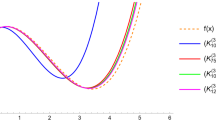Abstract
In this paper we continue our investigations of square function inequalities. The results in [9] are primarily one dimensional, and here we extend all the results to multi-dimensional averages. Our basic tool is still a comparison of the ergodic averages with various dyadic (reversed) martingales, but the Fourier transform arguments are replaced by more geometric almost orthogonality arguments.
The results imply the pointwise ergodic theorem for the action of commuting measure preserving transformations, and give additional information such as control of the number of upcrossings of the ergodic averages. Related differentiation results are also discussed.
Similar content being viewed by others
References
I. Assani, K. Petersen and H. White,Some connections between ergodic theory and harmonic analysis, inAlmost Everywhere Convergence (A. Bellow and R. L. Jones, eds.), Academic Press, San Diego, 1991, pp. 17–40.
E. Bishop,Foundations of Constructive Analysis, McGraw-Hill, New York, 1967.
J. Bourgain,On the maximal ergodic theorem for certain subsets of the integers, Israel Journal of Mathematics61 (1988), 39–72.
J. Bourgain,Pointwise ergodic theorems for arithmetic sets (Appendix: The return time theorem), Publications Mathématiques de l’Institut des Hautes Études Scientifiques69 (1989), 5–45.
A. P. Calderón,Ergodic theory and translation invariant operators, Proceedings of the National Academy of Sciences of the United States of America59 (1968), 349–353.
A. P. Calderón and A. Zygmund,On the existence of certain singular integrals, Acta Mathematica88 (1952), 85–139.
V. F. Gaposhkin,A theorem on the convergence almost everywhere of a sequence of measurable functions, and its applications to sequences of stochastic integrals, Mathematics of the USSR-Sbornik33 (1977), 1–17.
V. F. Gaposhkin,Individual ergodic theorems for normal operators on L 2, Functional Analysis and its Applications15 (1981), 14–18.
R. Jones, R. Kaufman, J. Rosenblatt and M. Wierdl,Oscillation in ergodic theory, Ergodic Theory and Dynamical Systems18 (1998), 889–935.
R. Jones, J. Rosenblatt and M. Wierdl,Oscillation inequalities for rectangles, Proceedings of the American Mathematical Society129 (2001), 1349–1358.
B. Weiss and S. Kalikow,Fluctuations of ergodic averages, Illinois Journal of Mathematics43 (1999), 480–488.
Author information
Authors and Affiliations
Corresponding author
Additional information
R. Jones is partially supported by NSF Grant DMS-9531526.
J. Rosenblatt is partially supported by NSF Grant DMS-9705228.
M. Wierdl is partially supported by NSF Grant DMS-9801602.
Rights and permissions
About this article
Cite this article
Jones, R.L., Rosenblatt, J.M. & Wierdl, M. Oscillation in ergodic theory: Higher dimensional results. Isr. J. Math. 135, 1–27 (2003). https://doi.org/10.1007/BF02776048
Received:
Issue Date:
DOI: https://doi.org/10.1007/BF02776048




